How Fast Are Coyotes? Exploring Their Impressive Speed

How fast are coyotes? Coyotes, the speedsters of North America, clocking in at an impressive 40 miles per hour. Canis latrans, the scientific name for the coyote, is a canid species that is endemic to North America and is very adaptable.
At the shoulder, these creatures normally stand 32 to 37 inches (81 to 94 cm) tall and weigh 20 to 50 pounds (9 to 23 kg). Coyote speed is a topic that frequently caught the interest of both naturalists and laypeople. These canids’ intriguing environment exhibits an astounding capacity for reaching incredible speeds.
How Fast Are Coyotes?
Contents
- 1 How Fast Are Coyotes?
- 2 How Long Can a Coyote Run at Top Speed?
- 3 Roadrunner Speed – Are They as Fast as We Think?
- 4 Coyote vs. Roadrunner – A Legendary Race
- 5 Coyotes vs. Dogs – Who’s Faster?
- 6 The Wolf vs. Coyote Challenge – Who’s Swifter?
- 7 Coyotes – Are They Dangerous?
- 8 Can you outrun a coyote?
- 9 Coyotes Habits
- 10 Do coyotes hunt at high speeds?
- 11 FAQs
How Fast Are Coyotes? This is a very important question that will let us know the speed of the coyotes. The average speed of a coyote is approximately 20 to 30 mph (32 to 48 km/h). Coyotes can sprint for just a short distance before reaching a top speed of 40-43 mph (69 km/h).
They are skilled predators and opportunistic scavengers in a range of environments thanks to their medium size and mobility.
Coyotes are among the fastest runners in the animal kingdom. They can sustain these fast speeds for extended periods of time thanks to their tiny, flexible bodies and extraordinary stamina, especially while pursuing prey or fleeing from possible dangers.
Although individual speed might vary depending on factors including age, health, and environmental circumstances, it is important to keep in mind that this simply adds to the complexity of these magnificent animals.
How Long Can a Coyote Run at Top Speed?
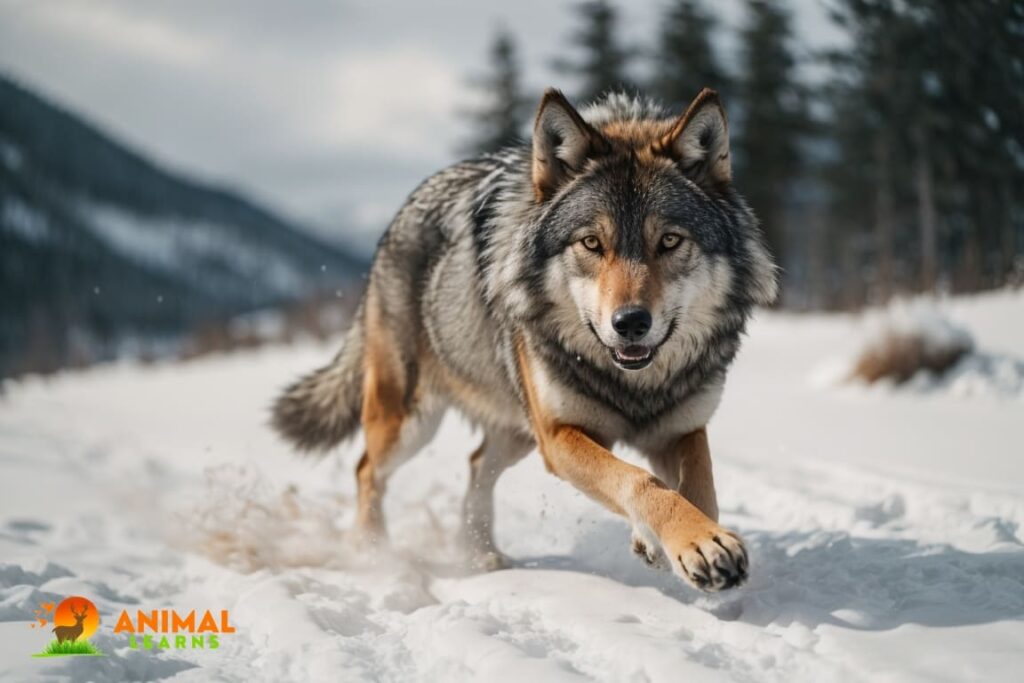
How fast are coyotes?” is a question that often leads us to discover the incredible adaptability and agility of these creatures. Let’s explore the exceptional physical qualities and stamina of coyotes, for sure. These canids have a perfectly balanced blend of speed and persistence.
How long a coyote can maintain its peak speed is a topic that must be solved in light of their amazing stamina. At its best, a coyote can follow prey at a high rate of speed for 20 to 30 minutes, moving up to five miles or more.
Their efficient circulatory and respiratory systems, which enable them to control body temperature well and prevent overheating during strenuous activities, are the source of this exceptional capacity. In addition, their lean frame, long legs, and unique paw pads help them maintain balance and have better grip on a variety of surfaces.
Roadrunner Speed – Are They as Fast as We Think?
Let us embark on a journey to uncover the true swiftness of roadrunners, intriguing avian creatures known for their remarkable agility. Inquiring minds often ponder, “How fast are roadrunners?” To address this query effectively, we must first dispel the common misperceptions that have arisen from their portrayal in popular culture.
Contrary to the exaggerated depictions in animated folklore, roadrunners are, indeed, swift birds, capable of impressive speeds. However, the reality of their velocity, when placed in the context of the natural world, reveals an equally astonishing tale of avian prowess.
Coyote vs. Roadrunner – A Legendary Race

| Animal | Maximum Speed (mph) | Average Speed (mph) | Notable Features |
| Roadrunner | Up to 20 mph | N/A | Rapid bursts of speed for evading predators |
| Coyote | Up to 43 mph | Up to 30 mph | Agile and versatile, used for both hunting and evasion |
In terms of speed, the famed roadrunner, known for its unusual look in popular culture, is no slouch. These birds can fly at astounding speeds of up to 20 mph, which enables them to easily avoid a variety of possible predators.
In the classic tale of the roadrunner and the coyote, a startling difference is revealed: while the roadrunner can get away quickly, the coyote is a powerful and nimble predator that can move at speeds of up to 43 mph in search of its elusive bird prey.
This dynamic contrast of speeds captures the essence of the never-ending pursuit, immortalizing everyone to see the roadrunner’s skill and the coyote’s unrelenting pursuit.
Coyotes vs. Dogs – Who’s Faster?
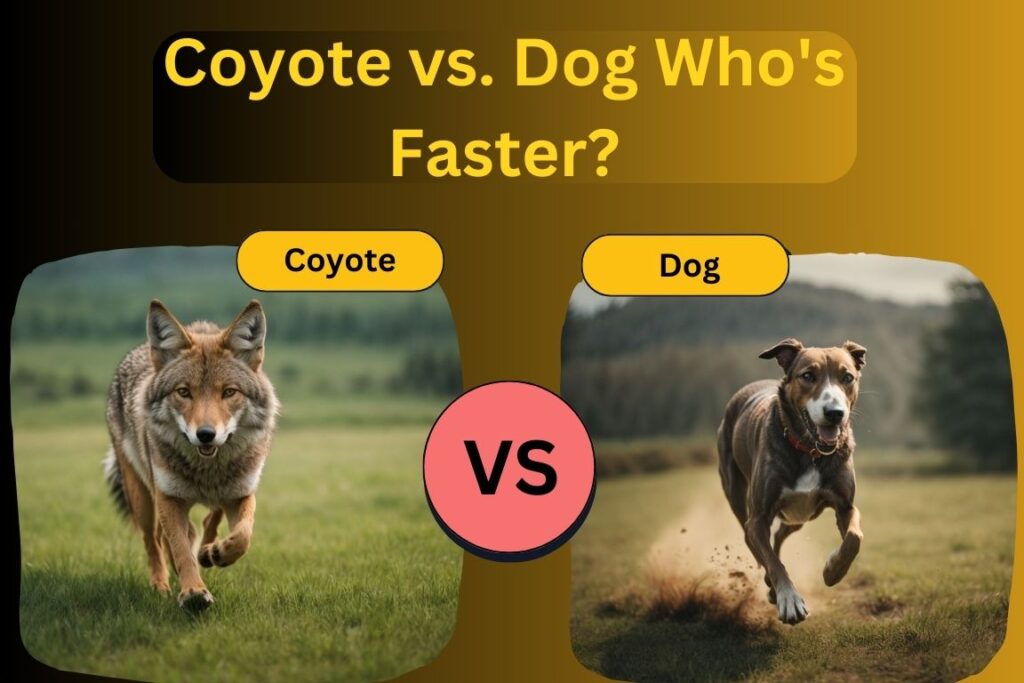
Despite the widespread assumption that coyotes move more quickly than dogs, the truth is more complex. Although both canids have outstanding speed, there are some noticeable differences in how well they sprint.
| Species | Peak Speed (mph) | Average Speed (mph) | Sprint Distance (miles) | Notable Breeds |
| Coyote | 40-45 | 25-35 | 1-2 | N/A |
| Greyhound | 45-47 | 35-40 | 0.5-0.75 | Greyhound |
| Whippet | 35-40 | 30-35 | 0.25-0.5 | Whippet |
| Border Collie | 20-30 | 15-20 | 5-10 | Border Collie |
| Dachshund | 15-20 | 12-15 | 0.25-0.5 | Dachshund |
The Wolf vs. Coyote Challenge – Who’s Swifter?
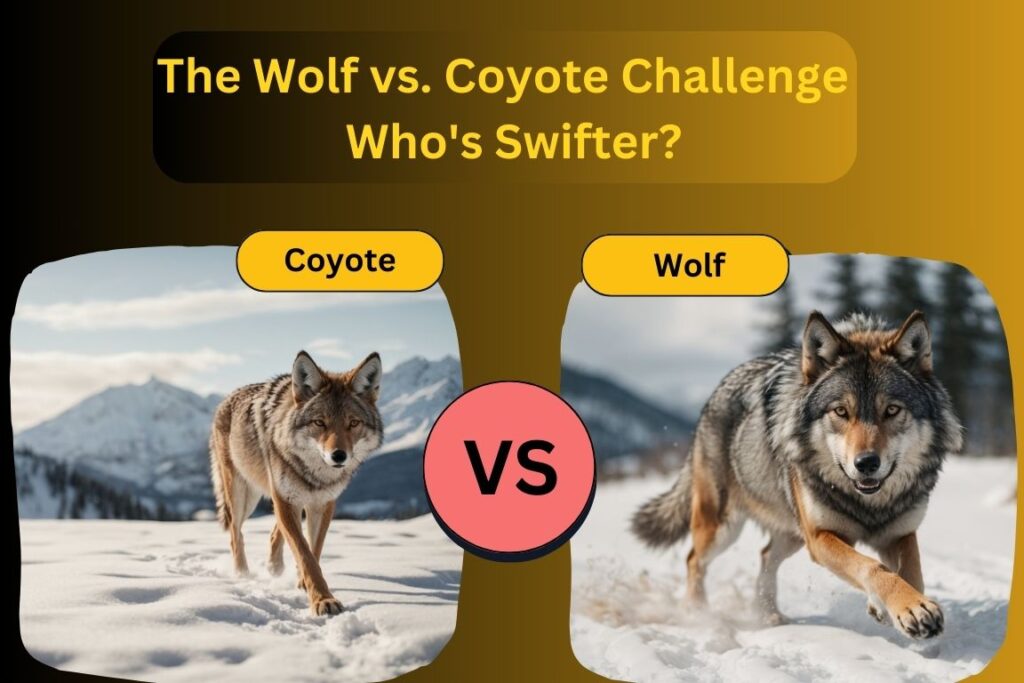
The relative speed of wolves and coyotes in terms of animal mobility piques our curiosity. In order to answer the question of whether the animal has the faster stride, wolves or coyotes, in-depth knowledge of their physiology and ecological functions is required.
Such research goes beyond simple curiosities and probes the fundamental core of ecological equilibrium. Each a representation of predatory power, the agile coyote and the magnificent wolf hold important characteristics that reverberate across the complex web of ecological connections.
| Animal | Maximum Speed (mph) | Average Speed (mph) | Notable Features |
| Coyote | 43 mph | 30 mph | Agile and Versatile, Solitary or Pack Hunter |
| Wolf | 40 mph | 25 mph | Strong and Enduring, Pack Hunting Abilities |
Coyotes – Are They Dangerous?
The coyote threat is not insignificant, but it should be recognized in the context of overall animal interactions. Coyotes are naturally wary and evasive creatures that steer clear of conflicts with people.
Coyote-human fights have, however, been extremely infrequent, and they frequently result from human behavior like feeding or acclimating these animals.
The potential threats posed by these adaptive organisms must be reduced via vigilance and appropriate cohabitation, and their presence as a vital component of our biological environment must be respected.
Are coyotes dangerous to humans?
Let’s investigate the fascinating issue of whether coyotes are a serious threat to people. Despite their natural suspicion of people, coyotes are not usually seen as harmful. Small animals, birds, and grass make up the majority of these canids’ diets, with sporadic excursions into scavenging.
Coyote-human disputes can happen, though, and they frequently result from human actions like feeding them, which makes them less wary in the first place. Such interactions may breed habituated behavior and, on rare occasions, apparent aggressiveness.
It is crucial to realize that following a few basic measures will assure human safety near coyotes: avoid feeding them, lock garbage cans, and keep small pets inside during vulnerable hours.
Can you outrun a coyote?
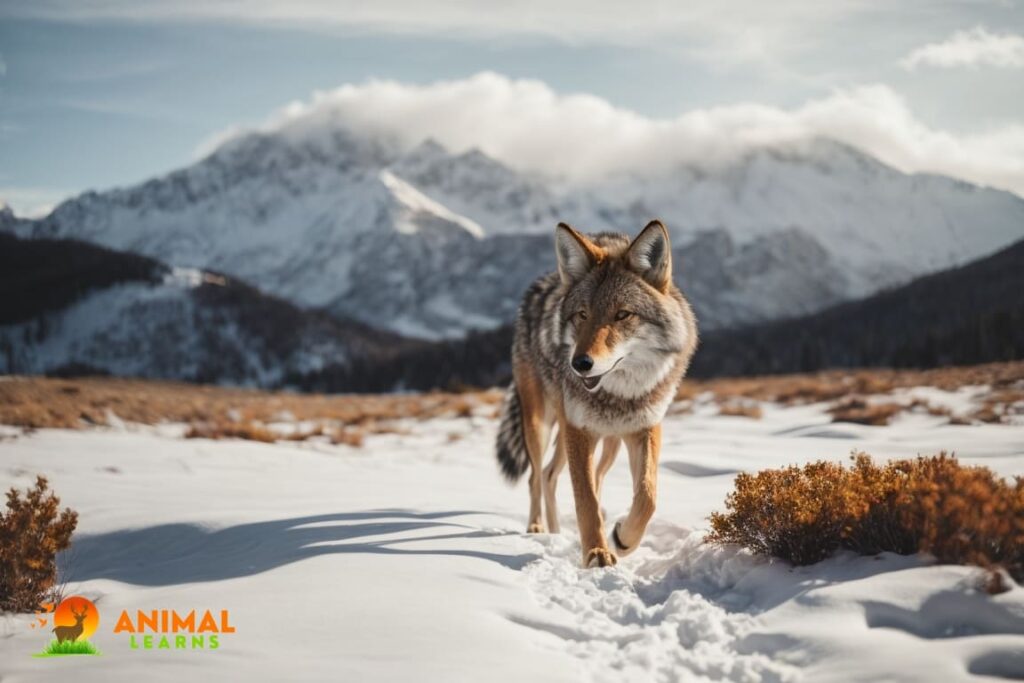
The question of “How fast are coyotes?” often raises concerns about personal safety, especially in regions where human and coyote habitats intersect. While coyotes are swift runners, humans can potentially outrun them over longer distances due to our own adaptability and endurance.
It’s important to recognize that coyotes are opportunistic predators and may choose not to pursue a human. However, maintaining a safe distance and preventing confrontations is paramount.
Understanding the dynamics of coyote speed versus human speed is a valuable aspect of coexisting with these fascinating creatures while ensuring safety for all parties involved.
Coyotes Habits
- Nocturnal Behavior: Coyotes are active at night because they want to escape daytime predators.
- Territorial nature: They create various-sized domains to ensure food security.
- Social Adaptability: Coyotes may adapt their behavior to the prey and population by living alone, in pairs, or in family groupings.
- Diverse Diet: They are opportunistic omnivores that eat fruits, insects, animals, birds, and carrion.
- Vocalizations: Coyotes use yips, howls, and barks to communicate about pack dynamics and territorial disputes.
- Food caching: By storing extra food for later use, they eliminate the need to go hunting every day.
- Urban Adaptation: Coyotes have adapted to urban life by scavenging and congregating close to populated areas.
- Seasonal reproduction: Mating takes place in the late winter, and families raise pups in the spring.
- Scent Marking: Coyotes mark their territory and maintain social order via smell.
- Amazing Endurance: Despite not being the quickest, they can sprint at 43 mph and maintain consistent trots.
Do coyotes hunt at high speeds?
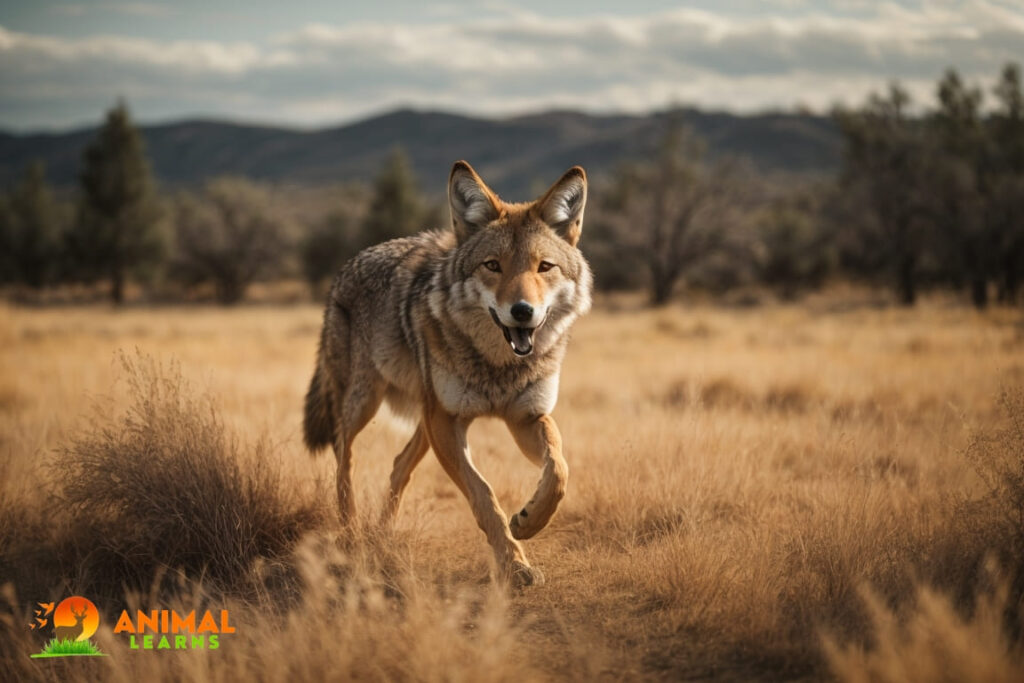
We know the answer to How fast are coyotes, Despite being renowned for their agility and speed, coyotes do not usually hunt by running after prey at great speeds. Instead, when hunting, they use a mix of tactics and cooperation.
Coyotes are opportunistic hunters who frequently track and ambush their prey with patience and skill. Although they can sprint for a short distance at up to 43 mph, they usually use this burst of speed for special occasions or to close up on prey that has escaped cover.
Their hunting style is characterized by flexibility and a blend of speed, strategy, and collaboration.
FAQs
How fast can coyotes run?
Coyotes can reach speeds of up to 43 miles per hour (69 kilometers per hour) in short sprints.
Are coyotes faster than domestic dogs?
In short sprints, some dog breeds can outpace coyotes, but coyotes have better endurance.
Do coyotes hunt at high speeds?
Coyotes often use bursts of speed to chase and capture prey but rely on strategy and teamwork for hunting.
Can coyotes keep up with vehicles?
Coyotes are known to keep pace with vehicles, particularly during their territorial pursuits or while chasing prey.
How does a coyote’s speed compare to other North American canids?
Coyotes are faster than red foxes but not as fast as gray wolves. They occupy a middle ground in terms of speed among North American canids.













